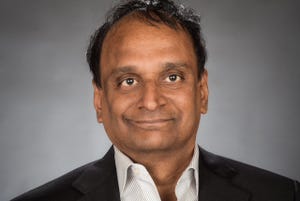Medical device developers should focus on these five outcomes to compete in today’s market.
July 13, 2015

Medical device developers should focus on these five outcomes to compete in today's market.
Steve McPhilliamy
It used to be that healthcare delivery was procedure- and fee-for-service-based, with physicians reimbursed for the number of procedures or services they conducted in the medical environment. Today, reimbursement has shifted to an outcome-based model, making the number of procedures and services less important than the resulting outcome. This changing model, driven by payers' growing focus on aligning reimbursement with things of greater value, such as patients' health and treatment efficacy, offers zero reimbursement for repeat visits to physicians for recurrent or similar problems stemming from treatment complications. It's less about how many times a procedure can be performed and more about administering the correct procedure that prevents repeat visits and leaves patients healthy.
Going forward, medical devices that will dominate the market will offer align with lower cost, higher quality, and better patient outcomes. The most successful healthcare solutions will streamline health care processes and offer intuitive and relevant functionality to all stakeholders.
Streamlining Processes
The value of device efficiency cannot be overstated. Beyond minutes of time saved through the development of an efficient solution, identifying opportunities to streamline processes in a given workflow can translate to an additional procedure performed effectively by a caregiver per day. Through in-context observation, developers can gain a full understanding of the actual caregiver cycle--from their preparations before a procedure begins through its successful completion--identify ways to optimize the process, and develop solutions that facilitate that optimization.
Take, for example, nasal surgery. During our field observation of surgeons performing a common ENT procedure using a handheld microdebrider, we noticed that each time the surgeon wanted to position the tool blade into an open or closed position, he or she would have to press a foot pedal repeatedly, attempting to align the blade. This process could take eight to 10 random foot presses in order to achieve a blade position adequate for use. What is even more interesting is when we interviewed the surgeons about the device they never mentioned or identified the problem. This finding led to a new magnetically controlled surgical blade positioning solution that the surgeon could use more efficiently, eliminating repetitive foot presses to control the blade location and offering greater control and accuracy. In this case, developing a better microdebrider against the identified needs offered surgeons hours in saved time and the ability to perform an additional procedure in a day.
Intuitive, Smart Functionality
Clear evidence of the growing market interest in intuitive smart solutions can be found throughout the mainstream, from Uber's simplification of a taxi experience to the ongoing development and progress of machine learning and its influence on the Internet of things. Health tech devices and system solutions developed around stakeholder needs; predictive, smart artificial intelligence; and elegant, simple functionality will gain widespread market adoption and lead to better outcomes ranging from early intervention on healthcare costs to enhanced safety in surgical procedures to more favorable patient health outcomes overall.
A leading opportunity for the development of smart, intuitive functionality lies in minimally invasive laparoscopic surgery. While these procedures are increasingly favored by surgeons for their ability to replace in-patient hospital stays with outpatient surgeries, they come with inherent risks based on a surgeon's limited device feedback and sensitivity to tissue in the areas they're operating on. Chief among these are accidental vessel cutting that can elevate the cost of care tenfold and radically change patient health outcomes. Responding to this opportunity, Insight Accelerator Labs member Briteseed successfully leveraged real-time low-cost sensor functionality in its development of SafeSnips, a vessel detection technology that prevents accidental cuts before they occur. This solution gives the surgeon intuitive, real-time feedback through the device itself to communicate what critical anatomy they are approaching and to provide greater clarity around what is hidden within the tissue before a cut is made.
Enhanced Patient-Doctor Communication
Few things can inhibit a better health outcome more than failures in patient-doctor communication. Take, for example, the postoperative communication between a surgeon and a patient that just underwent surgery. As the surgeon explains an extensive array of things to expect over the next three to four months of recovery, the patient, who is in shock to some degree, absorbs only a fraction of the conversation. As a result, when the patient experiences the changes described during their physician's download but fails to remember the prescribed instructions, they may panic or have issues that lead to multiple calls to the physician and the hospital to understand what they're experiencing.
Inspired by this specific challenge, Chicago startup Healthy-TXT developed a mobile communication platform that delivers real-time, targeted support to patients. Completely customizable, the platform allows users to receive personalized, automated messages around medical events ranging from postoperative care to a new diagnosis to starting a new treatment regimen. With direct links to Web pages, PDF, or video files, robust multimedia programs designed to engage patients can be created with the system around virtually any health event to increase patient comfort and quality of care, improve their health, and ultimately reduce cost burdens on the entire healthcare system.
Simplified and Targeted Education
Perhaps no greater opportunity exists to improve health outcomes than imparting knowledge to patients through focused education. However, while knowledge is power in health management, real challenges exist in converting that knowledge to patient motivation. Doing that requires keen developer understanding of specific patient population needs and translating those insights to appropriate solutions capable of improving health outcomes.
From support forums to gamification, developer solutions featuring incentive-based patient education can both simplify instructions and motivate patients. While use of gamification is gaining traction, many of these new digital device and software solutions are losing their target audience with the introduction of advanced technologies. With an understanding of this challenge, CareTree.com developed a platform that connects healthcare providers with a patient's circle of family and friends who are most comfortable with the new technology. When connected to a platform like CareTree, these higher-tech technologies have a tenfold greater probability of adoption and an exponentially greater chance of changing behavior.
Macro Data Translation
As an extension of simplifying education, perhaps the largest untapped opportunity to improve health outcomes at large is the translation and application of macro data through algorithms. Savvy developers can cross-segment aggregate patient data collected through electronic health records (EHRs) by patient geography, disease state, and culture and lifestyle trends to tailor new patient solutions that speak directly to the needs of niche populations. Tailoring solutions at this level is a powerful way to inspire and support individual behaviors that lead to better health outcomes for broad population swaths.
While no one has effectively cracked the code yet in macro data translation, several organizations are currently aspiring to leverage EHRs for the greater good. The American Heart Association and the Chicago Department of Public Health have their own respective designs on prevention-based programs that speak directly to individuals at risk for heart disease and those at risk for the leading chronic health conditions native to Chicago.
Not only will developing new user-centered solutions focused on delivering these outcomes align with today's value-driven healthcare reform; companies that take this approach will also have a clear competitive advantage in today's increasingly dynamic marketplace.
Learn about more trends in medical device design at MEDevice San Diego, September 1-2, 2015. |
Steve McPhilliamy is partner at Insight Product Development and executive director of Insight's Accelerator Labs in Chicago.
[Image courtesy of COOLDESIGN/FREEDIGITALPHOTOS.NET]
You May Also Like


.png?width=300&auto=webp&quality=80&disable=upscale)